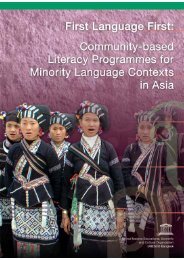Part II.pdf - MTB-MLE Network
Part II.pdf - MTB-MLE Network
Part II.pdf - MTB-MLE Network
You also want an ePaper? Increase the reach of your titles
YUMPU automatically turns print PDFs into web optimized ePapers that Google loves.
There is a lot of variation in the use of local languages in education, depending on the geographical<br />
area and ethnolinguistic group. There are strong and weak forms of bilingual education, and various<br />
shades in between. In the strong forms, an ethnic language, usually a regional LWC with a long<br />
literate history, is used as the medium of instruction from primary school through high school. In<br />
such programmes, Mandarin is taught as a second language starting from Grade 2 or 3. The balance<br />
between the use of the local and national language differs. Minorities benefiting from strong forms<br />
of bilingual education include Kazakhs, Koreans, Mongolians, Uygurs and Tibetans (Blachford 1997;<br />
Huang 2003; Leclerc 2004d; Stites 1999; Zhou 1992).<br />
The weak forms of bilingual education offer local language instruction in pre-primary education<br />
for a fairly short period of time (6-12 months). After this, the minority children are mainstreamed<br />
with Chinese speaking students. Blachford (1997, 161) calls this type “in name only” bilingual<br />
education. Other examples of the weak forms are cases in which ethnic languages are taught as<br />
a subject at different levels of the educational system (Blachford 1997; Stites 1999; Xiao 1998;<br />
Zhou 1992). The most common local language use in Chinese bilingual education is found in<br />
transitional programmes. Such programmes start with the students’ mother tongue, but as soon as<br />
the students understand Mandarin to some extent, it becomes the main medium of instruction.<br />
The transitional programmes aim to help children learn the national language, but maintenance of<br />
the mother tongue is not seen as important (Blachford 1997; Stites 1999; Xiao 1998; Zhou 1992).<br />
Chinese experience shows, however, that learning achievements of students in bilingual programmes<br />
– even some transitional ones – are better than in Chinese-only education for ethnic minorities<br />
(Blachford 1997, 161; Huang 2003; Xiao 1998, 230).<br />
Common difficulties faced in the use of local languages in China include: a lack of writing systems;<br />
a lack of qualified minority language teachers; a lack of texts and materials in minority languages;<br />
translation of textbooks from Chinese into minority languages without any adaptation; rapid transition<br />
from local languages to Mandarin; and negative attitudes towards the importance and usefulness<br />
of minority language education (Blachford 1997, 161; Cobbey 2003; Huang 2003; Lin 1997; Stites<br />
1999, 95; Zhou 1992, 43). Reasons for good progress in bilingual education endeavours in China<br />
include: positive and progressive approaches to bilingual education by local authorities, strong<br />
support of academics, and the major role of minority communities in curriculum development and<br />
materials production.<br />
Many minority languages of Southwest China or related varieties are spoken in South-East Asia,<br />
as well. In this region, there are documented examples of well-established programmes of bilingual<br />
education and mother-tongue literacy. Some of them are allegedly strong forms of bilingual education,<br />
as with Bai, Dai, Jingpo, Naxi, Zhuang and Yi languages (APPEAL 2001; Huang 2003; Jernudd<br />
1999; Liu 2000). In practice, however, few such efforts continue today, and in many “bilingual<br />
programmes,” the local language component is weak (Blachford 1997, 162-163). For example,<br />
the bilingual education for the Bai cited in the literature has not been continued, except in a very<br />
limited way to help older elementary school students improve their essay writing (L. Billard, pers.<br />
comm. 2004). However, plans to implement a new bilingual project amongst the Bai are underway.<br />
Very promising are recent experiences among the Dong (or Kam) of Guizhou Province. A<br />
nine-year pilot programme of bilingual education launched in 2000 uses Dong and Mandarin, starting<br />
with two years of preschool in which only Dong is used. Mandarin is introduced in primary school,<br />
108
















